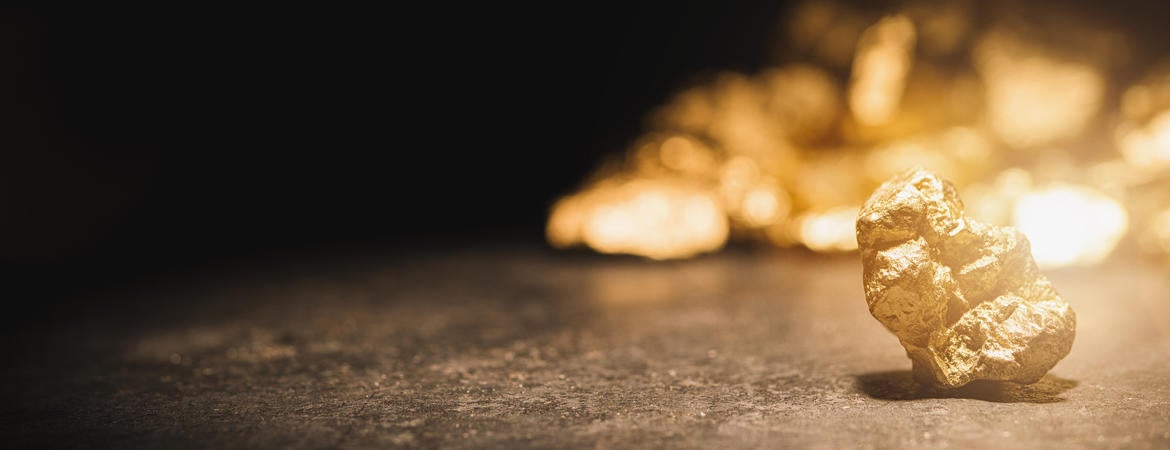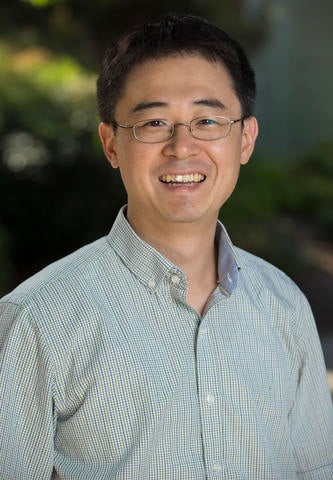
A team of physicists at the University of California, Riverside; Massachusetts Institute of Technology; and Hong Kong University of Science and Technology has observed evidence of Majorana fermions — particles theorized to also be their own antiparticle — on the surface of a common metal: gold. This is the first sighting of Majorana fermions on a platform that can potentially be scaled up.
The results, published in the Proceedings of the National Academy of Sciences, are a major step toward utilizing Majorana fermions as stable, error-proof qubits for quantum computing.
“Following our earlier work, the newly developed heterostructures of gold have been considered as a candidate with high potential for demonstrating Majorana fermions,” said Peng Wei, an assistant professor of physics and astronomy at UC Riverside and a member of the research team. “Our new work now has confirmed the sight of Majorana fermions, in fact a pair of them, in this gold heterostructure.”
In particle physics, fermions are a class of elementary particles that includes electrons, protons, neutrons, and quarks, all of which make up the building blocks of matter. The English physicist Paul Dirac predicted all fermionic fundamental particles should have a counterpart, somewhere in the universe, in the form of an antiparticle — essentially, an identical twin of opposite charge.
In 1937, the Italian theoretical physicist Ettore Majorana extended Dirac’s theory, predicting that among fermions, there should be some particles, since named Majorana fermions, that are indistinguishable from their antiparticles. Mysteriously, the physicist disappeared during a ferry trip off the Italian coast just a year after making his prediction.
Scientists have been looking for Majorana’s enigmatic particle ever since. It has been suggested, but not proven, that the neutrino may be a Majorana particle. On the other hand, theorists have predicted Majorana fermions may also exist in solids under special conditions.
The research team, led by Jagadeesh Moodera and Patrick Lee at MIT and Wei at UCR, has now observed evidence of Majorana fermions in a material system they designed and fabricated, consisting of nanowires of gold grown atop a superconducting material, vanadium, and dotted with small, ferromagnetic “islands” of europium sulfide. When the researchers scanned the surface near the islands, they saw signature signal spikes near zero energy on the very top surface of gold that, according to theory, should only be generated by pairs of Majorana fermions.
“Majorana fermions are these exotic things that have long been a dream to see, and we now see them in a very simple material — gold,” said Moodera, a senior research scientist in MIT’s Department of Physics. “We’ve shown they are there, and stable, and easily scalable.”
“The next push will be to take these objects and make them into qubits, which would be huge progress toward practical quantum computing,” said co-author Lee, the William and Emma Rogers Professor of Physics at MIT.
“Seeing a pair of Majorana fermions is an important step toward making a qubit,” Wei said. “A pair of Majorana fermions means two Majorana particles appearing simultaneously. This is a fundamental property because one electron or fermion can be divided into a pair of coherently coupled Majorana fermions. This could be the first observation of the nonlocally stored quantum state of an electron, that is, an electron or fermion simultaneously appearing at two different locations separated in space.”
High risk
Scientists have looked for Majorana fermions in semiconductors, the materials used in conventional, transistor-based computing.
“There are several material platforms where people believe they’ve seen Majorana particles,” Lee said. “The evidence is stronger and stronger, but it’s still not 100% proven.”
The semiconductor-based setups to date, however, have been difficult to scale up to produce the thousands or millions of qubits needed for a practical quantum computer
“They require growing very precise crystals of semiconducting material, and it is very challenging to turn these into high-quality superconductors,” Wei said.
About a decade ago, Lee, working with his graduate student Andrew Potter, had an idea: Perhaps physicists might be able to observe Majorana fermions in metal, a material that readily becomes superconductive in proximity with a superconductor.
Scientists routinely make metals, including gold, into superconductors. Lee’s idea was to see if gold’s surface state — its very top layer of atoms — could be made to be superconductive. If this could be achieved, then gold could serve as a clean, atomically precise system in which researchers could observe Majorana fermions.
“When we first proposed this, I couldn’t convince a lot of experimentalists to try it, because the technology was daunting,” Lee said. “Jagadeesh and Peng really had to reinvent the wheel. It was extremely courageous to jump into this, because it’s really a high-risk, but we think a high-payoff, thing.”
Finding Majorana
“We need to overcome several challenges first to establish a metallic platform for Majorana fermions,” Wei said. “The challenges include confirming the surface state superconductivity in gold and significantly lowering the Fermi energy, which is very hard to do in metals.”
The team eventually solved the challenges by covering the surface of a gold thin film with a layer of europium sulfide — a unique magnetic insulator. They also confirmed the surface state superconductivity.
With the material platform developed, the team began fabricating the setup Lee envisioned years ago. They first grew a sheet of superconducting vanadium, on top of which they overlaid nanowires of gold layer, measuring about 4 nanometers thick. They tested the conductivity of gold’s very top layer, and found it did, in fact, become superconductive in proximity with the vanadium. They then deposited over the gold nanowires the islands of europium sulfide, a ferromagnetic material able to provide the needed internal magnetic fields to create the Majorana fermions.
The team then applied a tiny voltage and used scanning tunneling microscopy, a specialized technique that enabled the researchers to scan the energy spectrum around each island on the gold surface.
The researchers then looked for a very specific energy signature that only Majorana fermions should produce, if they exist. In any superconducting material, electrons travel through at certain energy ranges. There is however a desert, or “energy gap” where there should be no electrons. If there is a spike inside this gap, it is very likely a signature of Majorana fermions.
Looking through their data, the researchers observed spikes inside this energy gap on opposite ends of several islands along the direction of the magnetic field, which were clear signatures of pairs of Majorana fermions.
“We only see this spike on opposite sides of the island, as theory predicted,” Moodera said. “Anywhere else, you don’t see it.”
Moodera said the team’s setup, requiring just three layers — gold sandwiched between a ferromagnet and a superconductor — is an “easily achievable, stable system” that should also be economically scalable compared to conventional, semiconductor-based approaches to generate qubits.
Wei, whose lab at UCR focuses on studying the quantum and topological phenomena of electrons in new materials, explained that such a nonlocally stored electron or fermion state is the foundation for fault-tolerant qubits. Further, confirming the pair of Majorana fermions enables physicists to further explore their quantum nature.
“The next step is to make a qubit from these particles, and we now have some ideas on how to go about doing this,” Wei said. “Our findings already allowed us to design and fabricate topological qubits, and design the circuitry of topological quantum computing.”
Wei, Lee, and Moodera’s co-authors include former MIT postdoctoral student and first author Sujit Manna, along with Yingming Xie and Kam Tuen Law of the Hong Kong University of Science and Technology.
This research was funded, in part, by the John Templeton Foundation, the U.S. Office of Naval Research, the National Science Foundation, and the U.S. Department of Energy. Wei, a UCR alumnus, was also supported by a UCR startup fund; he came to UCR in 2016 from MIT.
Above is a modified version of the MIT news release written by Jennifer Chu.




